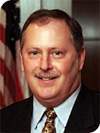Business Health Is More Than a Bottom-Line Consideration

Fitter employees make fitter businesses, and change can start at the top.
Newspaper editors used to call them “Hey, Mabel! Stories”—the kind of surprising content that could get people excited and talking about something they’d just read. I had my own Mabel Moment earlier this month, reading a USA Today story about obesity trends in America. According to that piece, experts now project that 42 percent of the people in this country—yes, nearly half—will be clinically obese by 2030.
Worse, one person in nine could be severely obese—100 pounds or more over their ideal weight. Both of those ratios are up sharply over almost any period you study. For a nation already tied in fiscal knots over health-care costs, that should scare all of us, because many of the illnesses driving the high cost of medical treatment today are the predictable consequences of lifestyle choices we’re making.
Try to imagine what will happen to that cost curve when you add 32 million more obese people to the mix.
Stories like that one resonate with me because of Kansas City’s reputation as a Fat City; we’ve been ranked as high as No. 1 in some magazine assessments, but thankfully Kansas City has moved off many of those Top 10 lists. Something we heard when reporting for this month’s issue may have a bit to do with that: Business executives here, more so than in many larger metropolitan areas, are on board with programming to help improve the overall health of their work force.
Experts aren’t quite sure why that is, but roughly a decade ago—and completely counter to a history that shows trends move into this region from the coasts, not the other way around—businesses here started moving the needle on employee health. I’d like to think that’s true, because what we at Ingram’s have found is that executive leadership does indeed drive success in corporate wellness programming. And that’s a subject taking on increasing importance for companies, as you’ll see in the 2012 Healthcare Industry Outlook report and accompanying editorial content that begins on Page 45 of this issue.
One Proven Solution
Which brings us to Ingram’s 2012 Fittest Execs and Fittest Companies Challenge, soon to be engaged in the fourth installment this summer. Through the first three years of the Challenge, Ingram’s and our corporate sponsors have been able to demonstrate the value of such programming. I’m no poster child for fitness, but I still take quite a bit of pride in finishing second last year in my age category for men in the Challenge, raising my overall health score by 18 points on a 150-point scale. Unfortunately, I have a good deal of capacity to improve more.
Not everyone will see that kind of success, especially in such a short period—the competition runs roughly four months from August into December. But as health experts have consistently told us, we didn’t get into the obesity “epidemic” overnight, and we won’t get rid of it with a magical medical bullet. It will take consistent application of commitment and effort to drive results, but this is one area where the KC business community can come together to achieve that kind of widespread success.
How widespread? In each of the first three years of the Fittest Execs and Fittest Companies Challenge, more than 80 percent of the contestants who completed the competition saw improvements in their overall health scores. Quite literally, hundreds of people have improved their health by taking part.
A key reason for that is the power of information: Each contestant undergoes a rigorous health-risk assessment at the onset of competition, a detailed analysis of 15 health metrics that cover everything from body-fat percentage, blood pressure and glucose counts to flexibility, upper and lower body strength and blood lipids.
Armed with that specific knowledge, each contestant is able to personalize a fitness plan that will help improve on the greatest areas of need. Test-out in December confirms the level of progress made by each participant.
The best part about it is the individualization factor. As we noted in this month’s reporting, people bring different mot-ivations to a workplace wellness program. That’s one reason why a one-size-fits-all approach often produces unsatisfactory results when viewed across the whole work force. Some Fittest Execs participants have success with diet, some with mild exercise, some with gym-rat dedication. But in sum, they are indeed moving the health needle.
A registration form for this year’s Fittest Execs and Fittest Companies Challenge is on Page 48 of this issue. I challenge you and your organization to participate in this year’s competition.

Joe Sweeney
Editor-In-Chief & Publisher
JSweeney@IngramsOnLine.com